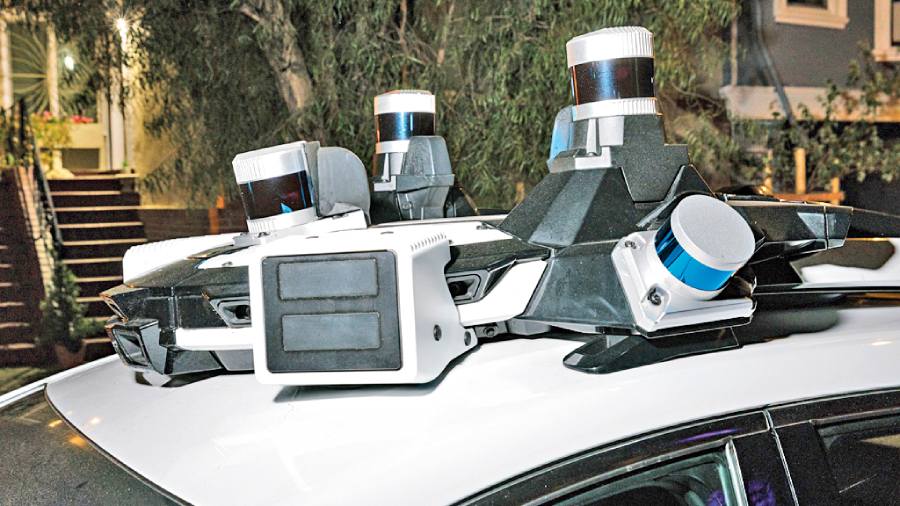It was about 9pm on a cool Tuesday evening in San Francisco in the US in September when I hailed a car outside a restaurant a few blocks from Golden Gate Park.
A few minutes later, as I waited at a stoplight, a white Mercedes pulled up next to me. Three teenagers were sitting on the edges of its open windows, their heads bobbing above the roof. One of them pointed at the empty front seat of my car.
“Who’s driving?” he yelled.
“No one,” I yelled back.
I was riding in a driverless car operated by Cruise, a company backed by General Motors that is now offering low-cost rides to a limited number of lucky and notably brave people in San Francisco, US.
Our car that evening, a small Chevy Bolt with a roof rack full of sensors, changed lanes on its own. It waited for pedestrians and their dogs to amble past before accelerating through a crosswalk. It wove around cars parked in the middle of the street with their hazard lights blinking.
Not to say there weren’t issues. As the car passed the joyriding teenagers a second time, it swerved sharply to the right, presumably because it mistook them for pedestrians. At another intersection, it hit the brakes just as the light changed to red, skidding to a stop in the middle of a crosswalk, its nose sticking out into the intersection. A pedestrian yelled at my robot driver and flipped it off as he walked by.
And then, just as we hit some nighttime traffic, the car detected a possible accident and pulled over. It was a false alarm, but the car wouldn’t budge. My ride was over.
Someday you too could ride in a truly driverless car. Cruise, which expects to expand its services to Austin and Phoenix in Texas by the end of the year, is among the companies now developing robot taxi services in major American cities. Waymo, which is owned by Google’s parent company, is preparing a second service in San Francisco. Argo AI, backed by Ford and Volkswagen, is at work in Austin and Miami. Motional, backed by Hyundai, is focussed on Las Vegas.
But the technology remains a work in progress.

My trip began at a neighbourhood restaurant. A Cruise employee told me that I would need to download the company’s app to hail a car. The app works only on iPhones.
Jason Henry, a photographer, would join me for the ride, which the app said would take about 21 minutes, or about 50 per cent longer than what an Uber with a human driver would typically take.
When the car arrived a few minutes later, we climbed into the back seat (riders aren’t allowed in the front), and, soon enough, a disembodied voice greeted us.
We pressed a big red button on one of the tablet computers in front of us and rolled forward at a law-abiding pace that seemed incredibly slow compared with the average Uber driver. An automated message warned us to keep our hands and arms inside the car at all times.
When you are sitting behind a plexiglass shield like you would find in an old-fashioned New York City taxi, the front seat of a Cruise car looks like the front seat of any car — except there is no one in it. In the back, above the two tablet computers, there’s a button that lets you call tech support for help and a speaker through which that disembodied voice can talk to you.
That’s about it.
The car was a dutiful driver. When pedestrians strolled through a crosswalk in front of it, it responded with what seemed like confidence, inching forward patiently before accelerating at the very moment its path was open.
When it approached a construction zone marked off with orange cones and a giant yellow arrow, it smoothly navigated around it, waiting for another car to pass on the right before proceeding. It snaked around a truck illegally parked at a sharp angle against the curb. And it stopped more than once for pedestrians who seemed as though they were about to cross the street, although this often came with a jolt to the passengers in the back seat. It also had a habit of slowing in the middle of an empty block for no apparent reason.
We were interested to see how the car would handle the intersection, one of the busier corners in the city — and one, it turned out, with serious foot traffic for close to 9.30pm on a Tuesday. For much of the ride, the car seemed to take side streets rather than main roads, steering well clear of heavy traffic and unprotected lefthand turns. But, as we approached Van Ness, vehicles lined up both in front and behind us. Suddenly, the car called off its turn and pulled to the side of the street.
“A potential collision was detected,” the disembodied voice said.
Just before the car pulled over, Henry had rolled down his window halfway and perched his iPhone on the edge of the glass using a small tripod. The idea had been to get a better angle on what was happening in front of the car. After the ride, a Cruise spokesperson said the move had spooked the car. One leg of the tripod had been on the outside of the glass.
NYTNS











